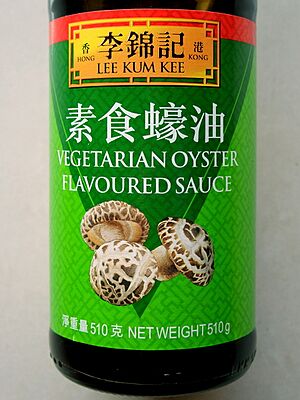Oyster sauce facts for kids
Oyster sauce is a thick, dark brown sauce made from oysters. It's a popular condiment used in many Asian dishes. You'll find it in Chinese, Thai, Malay, Vietnamese, and Khmer cuisine.
This sauce usually contains oyster extracts, sugar, salt, and water. It's made thick with corn starch. Some types might have caramel added to make them darker, but good quality oyster sauce is naturally dark.
Contents
How Oyster Sauce is Made
Making oyster sauce started in China a long time ago, around the 1870s. Back then, people would boil oysters in big pots. After boiling, the oysters were taken out to dry. The water left in the pots was then cooked down until it became a thick, dark sauce. Sometimes, sea-water, salt, or soy sauce was added.
Today, making oyster sauce is often quicker and cheaper. Modern oyster sauces usually start with a base of sugar and salt. Then, they are thickened with corn starch. To give it flavor, oyster extracts or essences are added. Other things like monosodium glutamate (MSG) or soy sauce might also be included to make the flavor deeper and add color. The quality of the ingredients really changes how the sauce tastes.
Some companies make oyster sauce by hand using traditional methods. But many manufacturers now use machines to make large amounts of it. This means that weighing, mixing, and cooking are done by automatic systems. The sauce is cooked at high temperatures in sealed systems. After cooking, it goes through pipes to be bottled and checked before it reaches stores.
Cooking with Oyster Sauce
Oyster sauce adds a delicious savory flavor to many dishes. It's a key ingredient in lots of Chinese home cooking. You'll often find it in noodle stir-fries, like Chow mein. It's also used in popular dishes such as beef with stir-fried vegetables. Sometimes, you can even use oyster sauce as a topping for certain foods.
Cantonese chefs have loved oyster sauce for a long time. They use it as a traditional umami-rich condiment. Umami is a special savory taste, often described as meaty or brothy.
Today, oyster sauce is used in many different types of cooking, not just Cantonese food. It can improve the flavor in dishes from Shandong cuisine, spicy Sichuanese cuisine, or seafood dishes from Jiangsu and Zhejiang cuisine. It helps bring out that wonderful umami taste.
Some dishes that often use oyster sauce include:
- Crab in oyster sauce
- Chinese broccoli
- Buddha's delight (a vegetarian dish)
- Hainanese chicken rice
- Lo mein (stir-fried noodles)
- Wonton noodles
Oyster Sauce vs. Fish Sauce
Even though both oyster sauce and fish sauce are salty and come from the sea, they are quite different.
- Fish sauce is usually watery, clear, and very salty. It has a strong smell.
- Oyster sauce is thick and made by cooking down oyster extracts. It's sweeter with just a hint of salt. It also has a milder smell compared to fish sauce.
Different Kinds of Oyster Sauce

A "true" high-quality oyster sauce is made by simply boiling oysters in water. This creates a white broth. This broth is then cooked down until it becomes thick and turns brown, like caramel. No other ingredients, not even salt, should be added because the oysters give all the flavor. However, this way of making it is very expensive.
Most modern oyster sauces are made differently. They are thickened with cornstarch, flavored with oyster essence or extract, and made dark with caramel.
Vegetarian Oyster Sauce
If you don't eat meat, there's also a vegetarian oyster sauce. It's made from mushrooms, often oyster mushrooms or shiitake mushrooms. This type is usually cheaper. It might have more taste enhancers if less mushroom extract is used to keep costs down.
MSG-Free Oyster Sauce
Many oyster sauces you find in stores have added monosodium glutamate (MSG). MSG is a flavor enhancer. But in recent years, you can also find varieties of oyster sauce that do not have MSG added.
See also
 In Spanish: Salsa de ostras para niños
In Spanish: Salsa de ostras para niños

